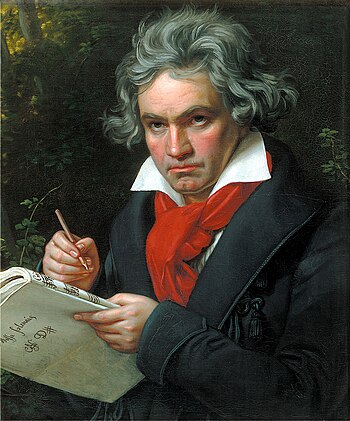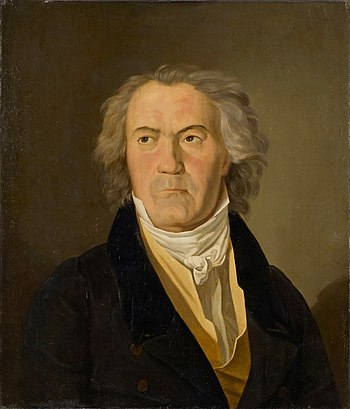Beethoven in 1818 by August Klöber
(Photo credit: Wikipedia)
(Photo credit: Wikipedia)
Let's put aside everything that we've been told about Beethoven and consider this question. It's an ugly question that will probably provoke aggression, but it is nevertheless interesting.
What is the evidence that Beethoven was deaf? Scrounging through literature and websites shows many anecdotes, letters, and references to an autopsy report (of which the original has been lost). It looks pretty promising, however, we really can't definitively say whether or not it is authentic. This is where this post begins to sound like a conspiracy theory, but rest assured, I'm only trying to use an example to ask a larger philosophical question.
Beethoven's biggest legacy could be his development of the idea of how we think of artists. His music broke the classical boundaries and originated the idea of the brooding, highly individual artist (as opposed to the former artisan status of composers). At the time, his music was very avant-garde and widely criticized. That's not to say that his music was bad, it was arguably pretty amazing, however, it wasn't what people were used to, and in order for people to accept progress, they need to think that it's worth their time to do so. This is where it gets interesting. For argument's sake, let's say that Beethoven was a genius. The problem posed to him was: How do I get people to give this music a chance?
Imagine you are a 19th-century citizen. It is a Friday night and you're looking to go out and have a good time. You hear that there is a concert being given with some new Beethoven piece. You're slightly interested. Then you hear the rumor that Beethoven's gone deaf... What? At this point, you are fully interested. You feel compelled to go, even if it's just to laugh at the chaos of the music. That is exactly the type of person that Beethoven's music would snare.
Their minds would be open and without expectation for normal classical-era music. What happens when you go to this concert and the music is actually really good? It is human nature to love stories of brave people overcoming tragedy, therefore people would want for his music to be good and would be more likely to pay attention and accept his eccentricities as a genius. Beethoven was notorious for stopping concerts if he felt he wasn't being given full attention. Did his deafness not afford him exactly the attention wanted?
 |
| The bust statue of Ludwig van Beethoven by Hugo Hagen (Photo credit: Wikipedia) |
This apparently had a wonderful effect on the guests who felt deep sympathy for him and his courage. Nice one. Another piece of evidence for his self-romanticization is in his letters in which he says things such as: "Live alone in your art! Restricted though you be by your defective sense, this is still the only existence for you" or my personal favorite "Perfect the ear trumpets as far as possible, and then travel; this you owe to yourself, to mankind and to the Almighty! Only thus can you develop all that is still locked within you;-- and a little court,--a little chapel,--writing the music and having it performed to the glory of the Almighty, the Eternal, the Infinite---".
Oh, what a tragic character he is. What makes it so much more charismatic is that it's a true story! The references to religion are particularly interesting. It gives him so much more power to say that he is driven by divine forces.
It would seem as though he was trying to employ a gimmick or create a character for himself. Where would he have gotten an idea like this? Why was the timing for this "deafness" historically logical? The answer to both of these questions could be Mozart. The concept of Mozart is a perfect father to Beethoven's deafness.
Mozart was also, to a lesser extent, a romantic character. His music is backed by a story. The story of a child genius, born only to compose and enchant. He was writing symphonies by the time he was 8. Wow! It didn't matter that the music was bad, people didn't care about the music, they cared about the story. His father was also a musician, so who knows how much of these early works were actually Wolfgang. I'm not trying to say that all of Mozart was a sham and that he's a worthless composer, just that he was founded on a gimmick. His later music is actually quite good.
Nevertheless, the gimmick was quite successful and everyone wanted to see the freak of nature that was Mozart. The idea of the child genius caught on and many people tried to replicate it exactly. Beethoven, a huge fan of Mozart, could have seen this gimmick and wanted to have his own. Thus the age of gimmicks (that is still alive today) was born.
The gimmick is such a powerful tool in art. Beethoven's legacy has proven this to us. Ask anyone today about Beethoven, and you will just as likely hear a reference to his deafness as to an admiration for any particular piece. In fact, I would argue that the average person would know Beethoven only by his deafness. To demonstrate the power of the gimmick, imagine showing a person the second movement from Beethoven's Moonlight Sonata.
It's a beautiful piece to be sure. Imagine their expression when you tell them that it was written by a deaf composer and that it saved him from suicide. Just then, the piece transforms from a beautiful piece to a compelling testament to the triumph of human perseverance. Although it's only a partially true statement, the effect that it has on the listener is enormous. My question here is: If backstory can create such a powerful effect, why would a genius such as Beethoven not seek to employ is strategical?
|














